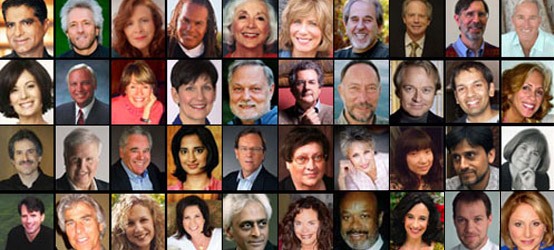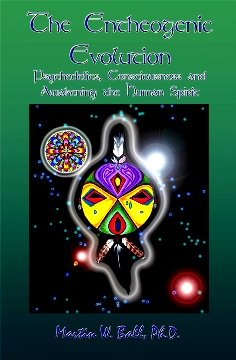Lecture
6b:
Visionaries: Summary
Adam Blatner
(This is the Last Part of the 6th and
last
in a 6-lecture series for Senior University Georgetown, October
31,
2011) The first lecture, introduced the idea of visionary and the different types, considering the paradigm shifts happening today.
 |
The third lecture addressed visionaries in psychology.
The fourth lecture extended these last two into the field of education
The fifth lecture considered the idea of consciousness evolution. (See the lecture given on that subject in 2009).
In the first part of the sixth lecture 2/3) we considered interspirituality.
This webpage summarizes the whole class..
The last six lectures have presented some visionaries who dare to forsee the potential for a better future. There are many more---I don't know all their names (see picture at right.)
I guess I'm one, too, insofar as my perspective is oriented this way, though I may be far less recognized or well-connected. Still, the point is that there are many, other than ones I' ve been mentioning: Ken Wilber in transpersonal psychology and contemporary philosophy; Jacob L. Moreno, in psychotherapy, social psychology, creativity theory; Maria Montessori, in education and child development; Abraham Maslow in humanistic psychology; Wayne Teasdale for interspirituality; Pierre Teilhard de Chardin about cosmic and psychic evolution; Alfred North Whitehead whose work in philosophy early last century generated a framework for the emergence of new trends in education and theology; and Barbara Marx Hubbard and the people she is drawing around her in pushing into the future. These and others have been discussed in the last lectures. As I've noted, I acknowledge many visionaries in social action, technology, and other fields, but my focus has been on the evolution of consciousness.
| Fractal art by Alfred Laing: Spiral Fantasy: |
 |
Art and Artists
I want to note that there are new forms of art being created with the help of computers and new fractal-based technology. To the left is another example, and I'll include some other examples of affirmative art scattered further down. Art and the arts in general may touch people's hearts in ways that mere words cannot reach. I confess to being logocentric in my own style---that is, I emphasize and value the activitiy of converting intuitions into rationally coordinated language---papers, books, web-pages, a blog. But I don't assume that many people share this. (I have grown to appreciate that this style is in the minority.) I don't assume that just because I am handy with words that makes me better, more entitled to money, more privileged, etc. Indeed, logocentricity has made it possible for literate peoples, backed up by lawyers, to defraud less literate peoples for several hundred years! If quirks in the law can be found, those without benefit of clever lawyers are left out; and this "symbol handling" has outclassed "thing handling" (e.g., farmers, craftsment) in ways that are oppressive.So art deserves to be re-integrated into education, where it has been marginalized---another postmodern bit of jargon that deserves to be brought into the mainstream: Non-rational functions such as music and art, and those that speak to the non-rational domains of human behavior---rhetoric, for example---deserve to be given more attention. We are more mythic and story-oriented than has been realized, as well as being more socially sensitive and embedded.
 |
Entheogens
This term has been used to describe that class of substances that evoke what in other contexts has been called "psychedelic" experiences. In smaller doses, or various controlled environments, these substances---mushrooms, cactus roots, chemicals---may be refined and applied in the service of criminology and other ways. What if it were possible to help young people in an overstimulating and distracting culture to connect with what the theologian Paul Tillich called the "ground of being," to be reminded of what mystics and saints (such as Albert Schweitzer) have called a "reverence for life"? Although such a suggestion is generally politically incorrect at present, I can't deny that there is potential for exploring the use of entheogens for healing, aiding the dying, fostering empathy, and so forth. It's another guess at what the future may hold.New Paradigms
I fear that term may be overused, but I am certainly guilty of throwing around the term "paradigm shift," because I see that we are in the midst of so many different kinds of rather deep changes in the fundamental ways we think, the key elements of value in our world. I think people living in the modern age were too materialist, too reductionistic, and too comfortable with attitudes that irrationally privileged certain Euro-American races, classes, types of education, skills, genders, life styles, and the like. It's worth re-examining the rational foundations for such social arrangements. (See my papers on oppression elsewhere on this website.) |
A major shift that has only barely happened is the idea that mind itself is worthy of respect as a fundamental element in reality---and not just mind as a general category, but non-rational mind as well as rational mind; poetry, sentiment, story, emotion, imagery, myth, and the like need to be recognized as forming the foundations of society as much as the highly rationalized left-brain realm of words. Don't get me wrong: I think the emergence of rationality has been a major development that must be cherished, but there is such a thing as overdoing it! What will it take to generate an ethos, a widespread valuing of nurturing our planet and other life forms rather than shamelessly exploiting it?
 |
Conclusion
There has been a program on the radio called "New Dimensions," coming out of the San Francisco Bay Area, the area that as I said in a previous talk may be recognized as a new Renaissance 500 years after the one that was centered in Florence, Italy. They introduce their interviews with some of the kinds of visionaries pictured above with this line:"It is only through a change in consciousness that the world will be transformed. The personal and the planetary are connected. As we expand our awareness of mind, body, psyche and spirit, and bring this awareness actively into the world, so also will the world be changed."
l